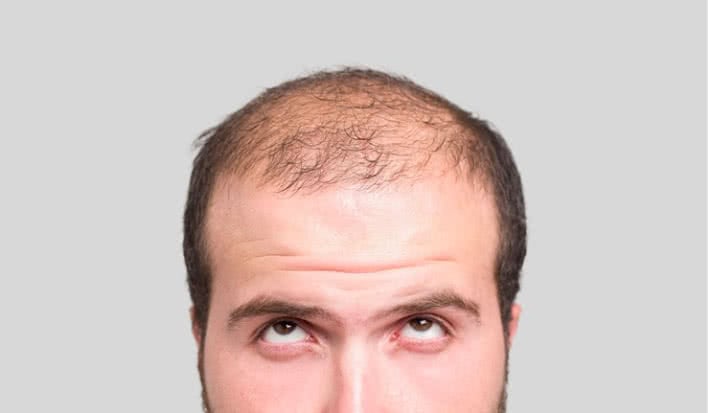Here’s a fact that will make your hair fall out: 1 out of 4 men start losing their hair to male pattern baldness before the age of thirty. Doctors estimate that 85% of men older than fifty suffer hair loss. The most common kind of hair loss is male pattern baldness (androgenetic alopecia), which is passed down from generation to generation.
Yes, we’ve got a lot to look forward to when we get old. Like wearing hats and avoiding windstorms and dodging tactile children who constantly want to play with our hair.

Male-pattern baldness got its clever name because it tends to follow a set pattern. The first stage is usually a receding hairline, followed by thinning of the hair on the crown and temples.
It’s caused when hair follicles are oversensitive to the hormone dihydrotestosterone (DHT), produced by the male hormone, testosterone. DHT causes the follicles to shrink and eventually stop functioning. Just look what DHTs did to DT’s (Donald Trump’s) crown. It defies the laws of nature, but adheres to the laws of hairspray.
This may not come as a news flash, but Mr. Trump is obsessed with hair loss. “Never let yourself go bald,” he once told a Trump Organization executive. “The worst thing a man can do is go bald.” He was apparently worried that if he cut his hair, he would lose his power and his wealth. He’s obviously confusing himself with the Biblical Samson. Or a Chia Pet.

Some scientific studies have suggested that the mother’s side of the family is to blame for this genetic predisposition towards baldness. Although there are many things we can blame on our mums (like those fun congenital defects), the truth is that most doctors now agree that baldness patterns are inherited from both sides of the family. Heredity also affects the age when hair loss begins, how fast it develops, and the pattern and extent of baldness.
Unfortunately, if you have inherited the genes responsible for male-pattern baldness, there’s little you can do to prevent it from happening. Once the hair follicle has stopped working, it’s done for.
There are some environmental factors can affect hair loss, too. Things like medication, infections, nutrition deficiencies, sudden weight loss or other physical or emotional shocks. Being the first to pass out on a lads’ weekend could result in a spontaneous head shaving as well, although that will most likely grow back.
Before I get into these so-called hair loss remedies, it’s important to note that hair growth is a colossal industry, with estimated annual sales of $3.6 billion. Ironically, all those dollars go towards products that do little to nothing to provide actual hair regeneration. Some can slow hair loss, but they don’t necessarily grow new hair. So, before you open up your wallet, open up your mind to the facts about the realities of the different ‘therapies’.

Propecia/Finasteride
This drug was originally created to help prevent prostate cancer and works by blocking production of a male hormone that shuts down follicles to cause male pattern baldness. Once you stop using Propecia, any hair loss that you would have had if you weren’t taking the medication will happen within a few months. Oh, and you could experience sexual side effects, like impotency. Which means although you may look good to the opposite sex, you may not be good for much in the sex department.
Minoxidil is another drug that was originally developed for something completely unrelated. In this case, a blood-pressure medication. Scientists theorise that Minoxidil protects the dermal papilla from DHT. It will help slow the hair loss process and probably is the best solution to help you hang on to your hair. And it has been known to help grow a wee bit of hair on the crown of your head, but of the peach fuzz variety. Like Propecia, if you ever stop using the medication, you will lose that fuzz and all the hair that you saved from its ultimate demise.

In-office laser light treatments supposedly grow new hair by stimulating blood flow to the area. This is not a baldness solution. It may, however, help you maintain more of the hair you have on your head. Just ask Shane Warne, as he swears by it. Of course, the company pays him to do so.
This looks so much worse than it sounds. Scalp reduction surgery involves cutting open the scalp and stretching the area of skin that can still produce hair over the area that is bald and no longer capable of growing hair.
It starts with the insertion of a balloon like device under the area of scalp with hair that is closest to the bald area. The balloon is filled with a salt-water solution to expand the tissue. Once the tissue has expanded to the required point, the balloon is removed and the bald area is cut away. The new, stretched skin is pulled over the gap and sewn up. Your head will look like you’ve survived a blunt hit by a medieval battle axe, but it’s worth it. Not!
A transplant is the best way of replacing lost hair. Fortunately, they’ve come a long way since the days when they used painful plugs that looked like unholy cornrows of thick, dark eyebrows sticking out of your skull.
Now, there is the strip method where your doctor surgically removes a strip of hair from the back of your head, dissects every hair graft under a microscope and then plants the individual grafts onto hair-thin areas of your scalp with tiny incisions. It’s that simple! A follicular unit extraction (FUE) is the scar-less way to go. In this method, grafts are harvested one at a time with tiny punches that heal virtually undetected. You’ve got roughly 100,000 hair follicles on your head. See how long that procedure will take you.

If you can’t beat baldness, join it.
Perhaps the best way to treat baldness is to embrace it. Research suggests that the shaved head look is on trend. In fact, some scientists with nothing better to do conducted a study that found when people looked at photos of the same men pictured with and without their hair, they saw the men as “nearly an inch taller and 13% stronger when pictured with shaved heads versus with hair.
So, with the tens of thousands you’ll save on expensive solutions and unsightly therapies, you can go and buy yourself a nice, shiny new razor. And look taller and stronger for it!


































